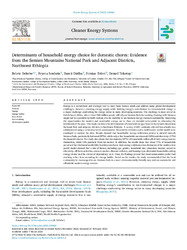| dc.contributor.author | Debebe, Belete | |
| dc.contributor.author | Senbeta, Feyera | |
| dc.contributor.author | Diriba, Dawit | |
| dc.contributor.author | Teferi, Ermias | |
| dc.contributor.author | Teketay, Demel | |
| dc.date.accessioned | 2023-04-03T07:49:53Z | |
| dc.date.available | 2023-04-03T07:49:53Z | |
| dc.date.issued | 2023-04-04 | |
| dc.identifier.citation | Debebe, B., Senbeta, F., Diriba, D., Teferi, E., & Teketay, D. (2023). Determinants of Household Energy Choice for Domestic Chores: Evidence from the Semien Mountains National Park and Adjacent Districts, Northwest Ethiopia. Cleaner Energy Systems, 100063. | en_US |
| dc.identifier.issn | 100063 | |
| dc.identifier.uri | https://doi.org/10.1016/j.cles.2023.100063 | |
| dc.identifier.uri | www.elsevier.com/locate/cles | |
| dc.identifier.uri | https://hdl.handle.net/13049/666 | |
| dc.description.abstract | Energy is a cornerstone and strategic tool to meet basic human needs and address many global development challenges. However, ensuring energy supply while limiting energy’s contribution to environmental change is a major challenge confronting the energy sector in many developing countries. The challenge is more severe in Sub-Saharan Africa, where about 900 million people still rely on biomass fuels for cooking. Cooking with biomass might not be a problem by itself. Instead, it is the inability to use biomass energy resources sustainably. Improving the opportunities for modern and sustainable energy use is, thus, an essential prerequisite to enhancing the livelihoods of the poor. This study examines the determinants of household energy choice in the Semien Mountains National Park and adjacent districts in Northwest Ethiopia. A survey of 420 randomly selected households was administered using a semi-structured questionnaire. Descriptive statistics and a multivariate probit model were employed to analyze the data. Results showed that households’ energy utilization pattern is skewed towards biomass fuels, particularly fuelwood (87%), while only a few households use charcoal (32%) and electricity (17%) for domestic chores. The study also shows that the majority (87%) of households collect all of their energy sources themselves, while 13% purchase from the market. In addition, the results show that about 77% of households perceived that fuelwood availability had decreased over time owing to deforestation. Estimates of the multivariate probit model showed that a mix of factors, including age, gender, household size, education, income, access to electricity, off-farm activities, access to market, distance to forest, and housing type, determine household cooking energy choice and the extent of dependency on it. Thus, the findings proved that local communities prefer fuel stacking rather than ascending the energy ladder. Based on the results, the study recommended that the local community be encouraged to use biomass fuels in a more environmentally friendly way and use sustainable and affordable modern energy sources. | en_US |
| dc.language.iso | en | en_US |
| dc.publisher | Elsevier | en_US |
| dc.relation.ispartofseries | Cleaner Energy Systems;100063. | |
| dc.subject | Biomass | en_US |
| dc.subject | Energy | en_US |
| dc.subject | Energy ladder | en_US |
| dc.subject | Fuel Choice | en_US |
| dc.subject | Fuel Stacking | en_US |
| dc.subject | Multivariate Probit | en_US |
| dc.title | Determinants of household energy choice for domestic chores: Evidence from the Semien Mountains National Park and Adjacent Districts, Northwest Ethiopia. | en_US |
| dc.type | Article | en_US |

